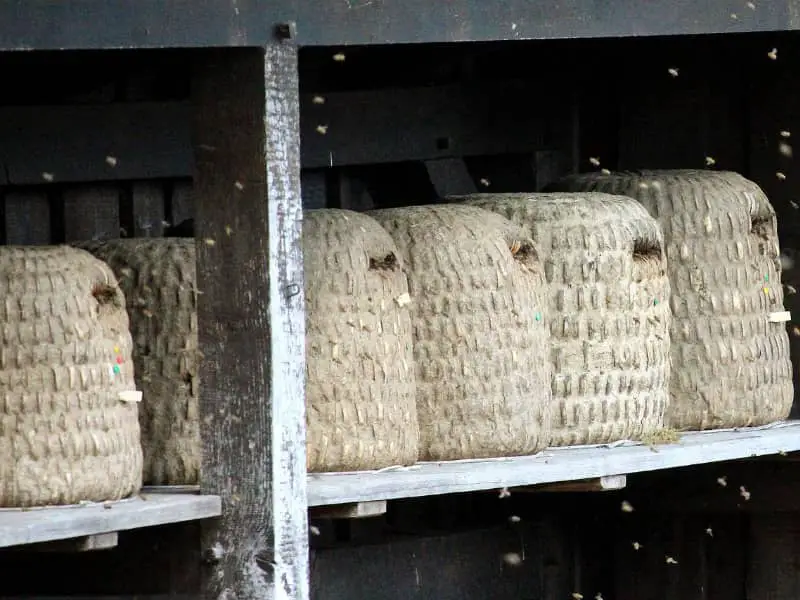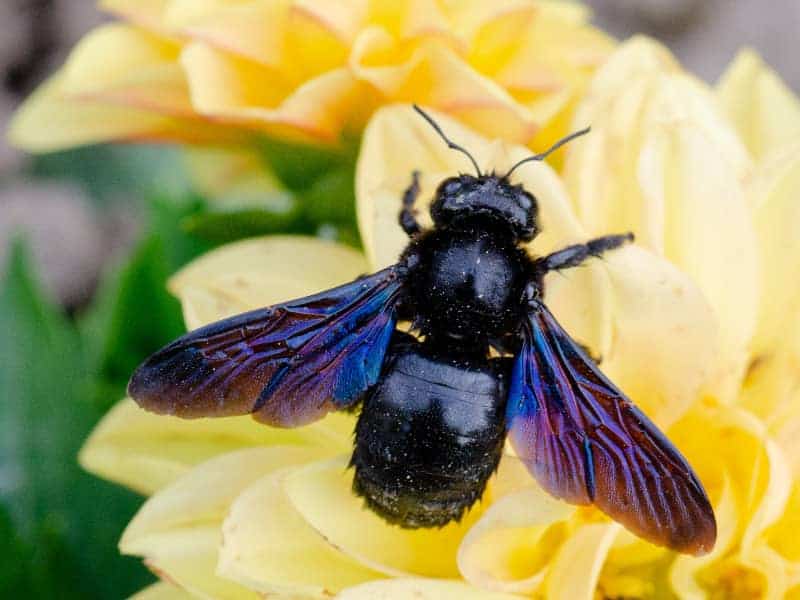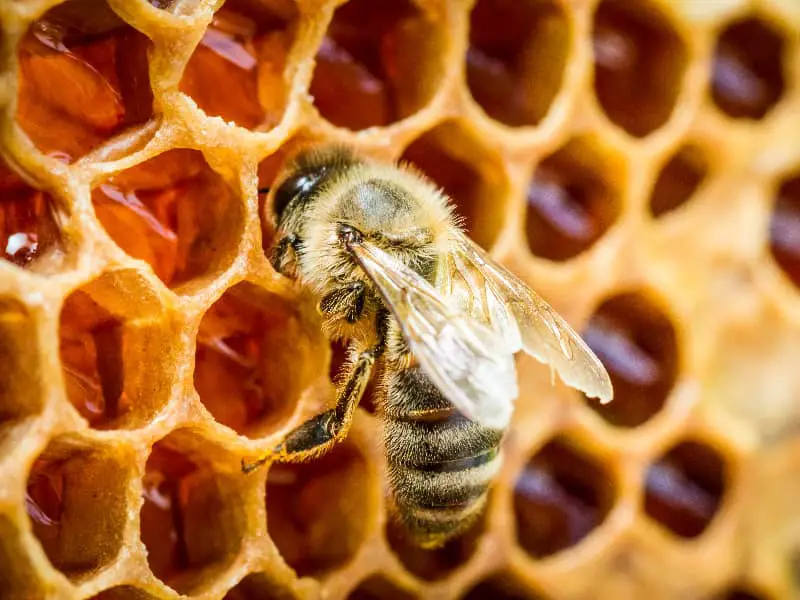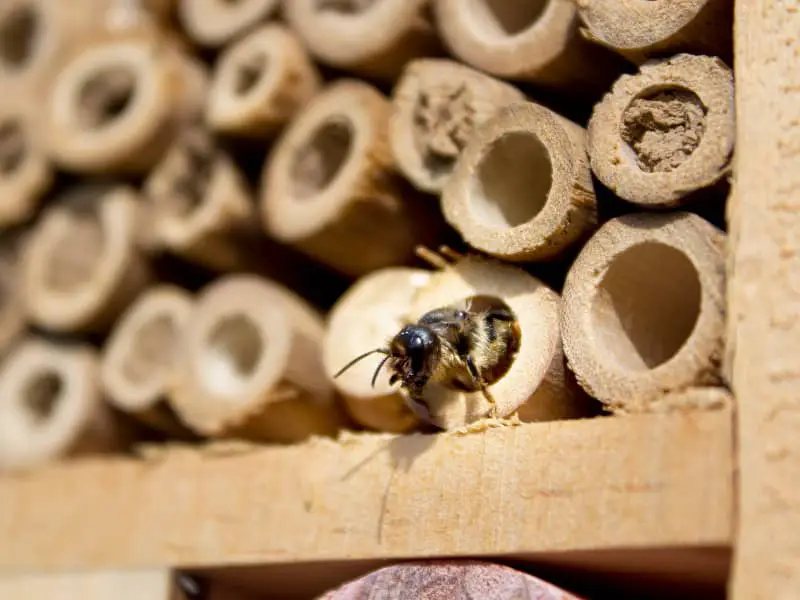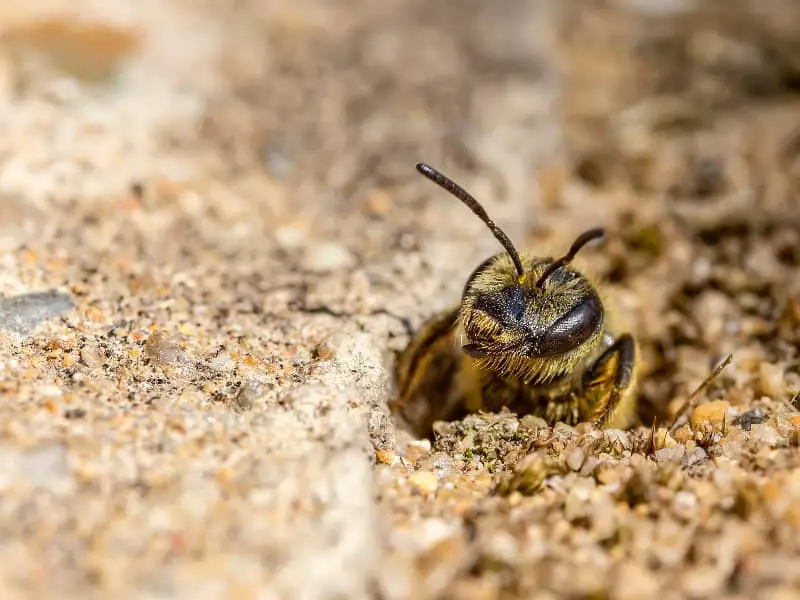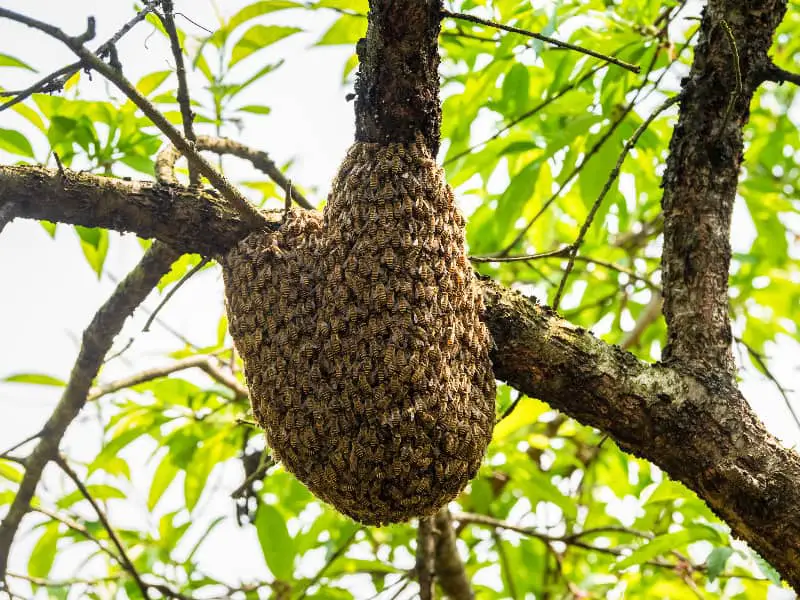
When do bees swarm?
The swarming of bees is a fascinating and often misunderstood phenomenon of nature. It is not only a spectacle for observers, but also a highly complex and vital behavior for the survival of bees. In this blog post, we take a detailed look at what swarming means for bees, why it happens, and what you as an interested reader should know about it.
- When do bees swarm?
- What does it mean when bees swarm?
- Basics of bee life
- Biological reasons for swarming
- Recognition sign of an imminent swarm
- When do bees swarm? - Best time to swarm
- How far do bees move when swarming?
- Swarming and beekeeping
- When do bees swarm? - Dangers
- When do bees swarm? - The sequence
- Conclusion: When do bees swarm?
What does it mean when bees swarm?
Swarming is a natural process in which part of a hive splits off and establishes a new hive. This usually occurs in late spring to early summer when conditions are most favorable. Swarming is a form of reproduction for bees and represents an opportunity to expand the gene pool and colonize new areas.
Why is swarming important?
Swarming has several important functions in bee life. Firstly, it serves to propagate the colony by enabling the establishment of new hives. Secondly, it provides genetic diversification, as the bees of a swarm usually mate with a new queen. Moreover, swarming is also a way for the colony to better manage resources. In times when the existing hive is overcrowded or there is not enough food, swarming can be an important survival strategy.
Blogpost overview
In the following sections, we will delve deeper into the topic and highlight everything from the biological basics of swarming to its impact on the environment and beekeeping. How you can prepare yourself as a resident or as a beekeeper for a swarming event will also be a topic. We will try to explain the complex biological and ecological relationships in an understandable and entertaining way.
Basics of bee life
Before we dive deeper into the topic of "When do bees swarm?" it is important to understand the basics of bee life. How does the social structure of a hive work? What role does the queen play in the overall structure? And how does the annual cycle change in a hive? All of these aspects are crucial to understanding swarming.
Social structure of a beehive
In a typical hive, there is a clear division of labor and hierarchy that ensures the survival of the colony. At the top is the queen, followed by the worker bees and the drones. The worker bees are responsible for various tasks in the hive, from gathering food to caring for the larvae. The drones have the primary task of mating with a queen. This social structure is essential for the efficient functioning of the hive and thus for successful swarming.
Queen role
The queen is the heart of the hive and has the important task of laying eggs. She produces pheromones that promote colony cohesion and keep the worker bees in line. When the queen ages or loses efficiency for other reasons, the colony recognizes this and prepares to produce a new queen. This is often a sign that a swarm is imminent, as a new queen will leave the old hive and start a new one.
Annual cycle in the hive
Life in a beehive follows a fairly predictable annual cycle. In spring and summer, bees are most active, collecting nectar and pollen and reproducing. This is the time when swarming is most likely to occur. Fall is the time of preparation for winter, during which bees wind down their activities and focus on overwintering. This understanding of the annual cycle is essential to understanding when bees typically swarm and why.
Now that you have a basic overview of social structure, the role of the queen, and the annual cycle of a hive, you are better prepared to understand the dynamics and timing of swarming....
Biological reasons for swarming
Now that we have looked at the basics of bee life, we can look specifically at the biological aspects of swarming. What drives a bee colony to swarm? What biological mechanisms underlie this behavior? And how is swarming integrated into the resource management of the hive?
Multiplication of the people
Swarming is a natural mechanism for colony reproduction. As a rule, a new swarm is led by a young queen who leaves the old hive to establish a new one. The worker bees follow her and together they search for a suitable place for a new hive. This behavior ensures the survival and dispersal of the bees, especially in times when the original hive is overpopulated or does not offer enough resources.
Genetic diversity
Another biological advantage of swarming is the increase in genetic diversity within bee colonies. By leaving the old hive and establishing a new one, the bees can mix their genes with other populations. This increases the adaptability and survivability of the colony. Genetic diversity is not only beneficial for the bees themselves, but also for the pollination of different plant species and thus for the entire local fauna.
Resource Management
Swarming is also an efficient way for the colony to manage its resources. A hive that is overcrowded or lacking in food can lead to stress and disease. Swarming reduces the population in a hive, providing more space and resources for the remaining bees. At the same time, it allows the swarm to open up new areas with sufficient resources, which increases the overall survivability of the colony.
Recognition sign of an imminent swarm
Swarming of bees is not random; there are certain signals and signs that announce an impending swarming event. Knowing what to look for can help you better understand when and why bees swarm. In this section, we look at specific tell-tale signs, including the emergence of queen cells, worker bee behavior, and general hive conditions.
RJ cells
One of the clearest signs of an impending swarm event is the presence of queen cells in the hive. These specialized cells are larger than normal brood combs and serve as a breeding ground for new queens. If you find RJ cells in a hive, it is an almost certain indication that the colony is planning to swarm in the near future. The new queen that hatches from the queen cell will either replace the old queen or leave the hive with a swarm.
Behavior of worker bees
The behavior of worker bees can also provide valuable clues about an impending swarm. You might notice that the worker bees are more nervous and restless than usual. They may also be collecting and storing more nectar in order to have enough resources for the swarm and the remaining hive. In addition, care activity for the brood may be reduced because swarming is imminent and resources are focused on swarm survival.
Stock conditions
Finally, the general condition of the hive is an important indication of an impending swarm event. A crowded or overheated hive increases the likelihood of a swarm. Similarly, a lack of food or water may favor swarming as bees seek better conditions. So careful monitoring of hive conditions can be critical to recognizing the signs of an impending swarm.
When do bees swarm? - Best time to swarm
Now that we have covered the identifying signs of an impending swarm, we come to the real question: when do bees swarm? The timing of swarming is not a coincidence, but is influenced by various factors. In this section, we will address the seasonal influences, diurnal preferences, and climatic conditions that determine the best time to swarm.
Seasonal influences
As mentioned in a previous section, the probability of swarming is highest in spring and early summer. This is because the most resources, such as nectar and pollen, are available during this time, which promotes hive growth. An overpopulated hive is more likely to swarm. In addition, the weather during these months is largely favorable for swarming, with high temperatures and little rain.
Time of day preferences
Interestingly, bees mostly swarm in the late morning or early afternoon. Experts suggest that this is related to the optimal temperatures and light conditions at this time of day. Moreover, by this time the bees have collected enough nectar to have the energy for the swarm flight.
Climatic conditions
The local climate also plays an important role in determining the best time for a swarm. Bees prefer warm, sunny and windless days for their swarming flight. Extreme conditions such as heat, cold, or high winds are not conducive to swarming. In areas with a temperate climate, conditions are usually best during late spring and early summer.
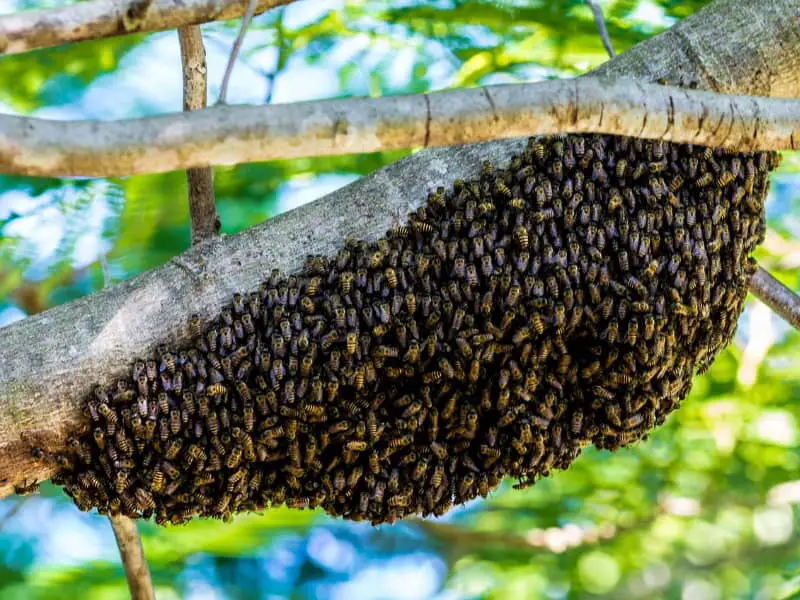
How far do bees move when swarming?
One of the most fascinating aspects of bee swarming is how far these little insects actually travel. Beekeepers and nature lovers are often amazed at how mobile a bee colony can be. In this section, we look at the average distances bees travel when swarming, the bees' remarkable ability to orient themselves, and other factors that can influence travel distance.
Average distances
The distance a swarm of bees travels can vary, but is often in the range of a few hundred meters to a few kilometers. This may not seem particularly far at first glance, but is remarkable for the size and energy capacity of the bees. The distance is usually large enough to avoid conflict with the hive of origin and yet small enough to minimize the risk of not finding a suitable new home.
Orientation ability of bees
The ability of bees to orient themselves over long distances is remarkable and is another factor that influences distances when swarming. Bees use complex navigation methods, including the position of the sun and possibly the earth's magnetic field, to determine their direction. This allows them to fly efficiently and purposefully to a new dwelling without getting lost.
Influences on the distance
Various external factors can influence the distance a bee swarm travels. These include the presence of natural barriers such as water bodies or mountains, the availability of suitable new nesting sites, and general weather conditions. Unsuitable weather, for example, may cause the swarm to travel a shorter distance to find shelter more quickly.
Swarming and beekeeping
Swarming of bees is a natural phenomenon, but one that causes mixed feelings in beekeeping. While it is a sign of growth and health for the bees, it presents both opportunities and challenges for beekeepers. In this section, we review the advantages and disadvantages of swarming for beekeepers, look at methods of swarm prevention, and explain how to capture a swarm.
Advantages and disadvantages for beekeepers
A swarm can be beneficial for beekeepers on the one hand, as it allows to establish a new hive and thus expand beekeeping. On the other hand, a swarm also means a loss of worker bees in the original hive, which can significantly reduce honey production. Furthermore, capturing an escaped swarm can be time-consuming and labor-intensive, especially if the swarm has settled in a location that is difficult to access.
Swarm prevention methods
There are various methods to prevent or at least minimize swarming of bees. One common method is so-called "artificial swarming," in which part of the colony, including the queen, is relocated to a new hive before a natural swarm occurs. Other techniques include regular removal of queen cells and expansion of the hive to avoid overpopulation.
Capture a swarm
If, despite all precautions, a swarm occurs, it is possible to capture it and integrate it into a new hive. To do this, the swarm, which usually settles on a branch or similar structure, is carefully shaken into a swarm trap box or empty hive. It is critical to capture the queen, as the worker bees will follow her. Once the swarm is captured, it can be relocated to a new hive.
When do bees swarm? - Dangers
As fascinating as swarming bees is, it is not without risks and dangers - both for the bees themselves and for humans, animals and the environment. In this section, we take a look at the different aspects of the dangers that can occur when swarming.
Risks for the bees
The decision of a bee colony to swarm is always associated with risks. During the swarm flight, the bees are exposed to weather conditions such as rain or strong winds, among others, which can weaken or even kill them. In addition, there is a risk that the swarm will not find a suitable new nesting site and will therefore remain unprotected and disoriented. Without food and shelter, the bees cannot survive.
Dangers for humans and animals
Although bees are usually not aggressive when swarming, they can be potentially dangerous to people and animals, especially those with allergies to bee stings. A swarm of bees near residential areas, schools, or busy public places can cause panic and uncertainty. Likewise, pets that disturb the swarm out of curiosity may be attacked by the bees.
Environmental impact
Swarming bees also have an impact on local flora and fauna. A new hive can alter the ecological balance in an area by drawing food resources away from other pollinators. In areas where bees are not native, they can be considered invasive species and negatively impact native plants and animals.
Swarming is a double-edged sword. While it is a natural behavior for bees that demonstrates their survival and adaptive abilities, it is fraught with various risks and challenges. A comprehensive understanding of these aspects is important for both beekeepers and the general public to respond appropriately to this natural phenomenon.
When do bees swarm? - The sequence
Swarming of bees is a fascinating process and testifies to the amazing organization and coordination within a colony. In this section, we review the different phases of the swarming process: from the initial phase to the middle phase to the settlement in a new place.
Initial phase
The initial phase of swarming begins already in the hive. Once the decision to swarm is made, the bees and the queen gather near the exit. Meanwhile, the worker bees fill their honey stomachs to have enough energy for the swarming flight. The queen is taken care of by the worker bees so that she is fit for the upcoming flight. This preparation process can take several days.
Middle phase
The middle phase begins with the actual departure of the bees from the hive. Led by the queen, thousands of bees leave the home and form an imposing swarm. They often fly to a nearby place where they temporarily settle, for example on a tree branch. Here they gather and reorient themselves, while so-called scout bees search the surrounding area for a suitable new home.
Branch
The final phase of swarming is settlement. Once a suitable location has been found, the bees make their way there. Once again, the queen is the first to enter the new hive, followed by the worker bees, which immediately begin to build combs and build stores. Settlement is crucial for the survival of the swarm and marks the completion of the swarming process.
Conclusion: When do bees swarm?
After a deep consideration of the topic "When do bees swarm?" we now come to the conclusion of this article. In the summary and conclusion, the most important findings are highlighted, the importance for beekeepers and nature lovers is illuminated and concluding thoughts are formulated.
Most important findings
Swarming of bees is a highly complex and fascinating process that is influenced by many factors. From the signs of an impending swarm to the specific conditions that favor swarming, there are many aspects to consider. Among the most important lessons learned is the need for observation and preparation to successfully manage the process and minimize negative impacts.
Importance for beekeepers and nature lovers
For beekeepers, swarming is both a challenge and an opportunity. It can mean the loss of part of the colony, but it also offers the chance to establish a new colony. For nature lovers and observers, swarming is an impressive natural spectacle that offers insights into the complex social structures and behaviors of bees.
Final thoughts
Swarming is a natural part of the life cycle of bees and a sign of the health and vitality of a colony. Although it comes with certain risks and challenges, it also opens up opportunities for renewal and growth. By better understanding this phenomenon, we can not only develop more effective methods for managing bee colonies, but also foster our own reverence and appreciation for these remarkable creatures.
With these concluding thoughts we would like to round off the topic "When do bees swarm?".
Author

-
Garden animal - A life with nature
Welcome to my animal blog! My name is Dirk and I am happy to take you on my journey through the fascinating world of animals and gardening.
Born 54 years ago, I have had an insatiable curiosity for the animal world around me since childhood. Although I have moved professionally in other industries, my true passion has always been animals and nature. It is remarkable how a small garden has become such an important part of my life.
Many of my fondest memories are associated with the animals that share our home. Whether it's the curious squirrels that scurry across the trees in the morning, the colorful variety of birds that visit our feeders, or the busy bees and butterflies that pollinate our flowers, every moment with them is invaluable to me.
This blog is my contribution to share my experiences, discoveries and insights with like-minded people. Here I will share stories of unforgettable encounters with animals, give tips on gardening and creating wildlife-friendly habitats, and take you on my journeys through nature.
Thank you so much for being here!
Cordial,
Dirk aka garden animal
Last posts
- 27. February 2024PetsVeganes Hundefutter – Grün und Gesund?
- 18. January 2024ChickensOregano für Hühner
- November 27, 2023HamsterDiurnal hamsters
- November 24, 2023HamsterHamster hammock

